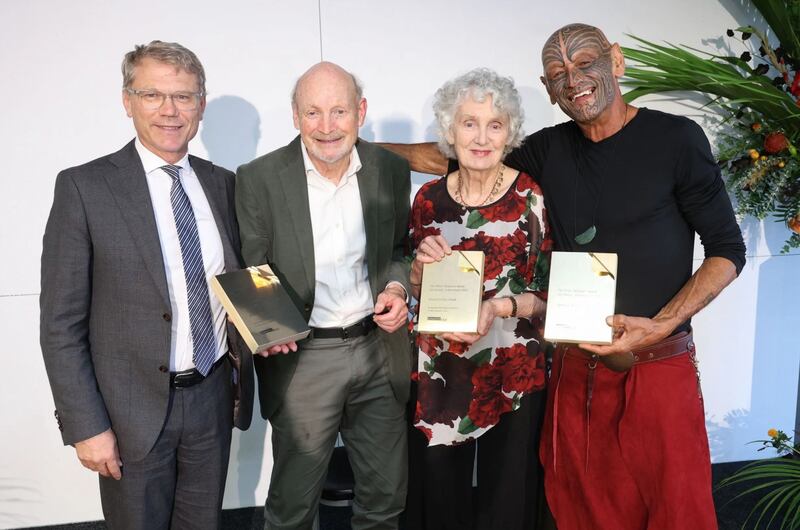Kua whakawhiwhia a Apirana Taylor o Ngāti Porou, Te Whānau a-Apanui me Ngāti Ruanui ki tētahi tohu a te Pirimia, e whakamānawa nei i ōna pūkenga mō te tā toikupu.
E toru ngā tohu a te Pirimia ka whakawhiwhia ki ngā tohunga matatau ki te reo matatini i ia te tau, ā, he mea kōkiri ngā tohu nei e Toi Aotearoa.
E 50 tau neke atu a Taylor e tā nei i te kupu. Hāunga rā te wāhi ki te tā toikupu, he tohunga hoki ia ki te tuhi whakaari.
E ai ki a Apirana, he toikupu te reo Māori.
“In our Māori culture, the talent is there in abundance. In our spoken oratory, on the marae, and interestingly, it’s in our literature and our art. We take the wairua and put it into the pen.
“E tipu e rea’ I think it’s the most relevant poem for Māori people still to this day.”

He kauwaka te reo Māori ki te whakaputa whakaaro
Ko te kaitā toikupu Māori, ko Te Kahu Rolleston, e whakapono ana ko te reo Māori tētahi kauwaka e puta ai ngā whakaaro auaha, te wairua o te tangata i āna tuhinga.
Hai tāna ko te tā i te toikupu tētahi mahi e maringi noa mai ana i te waha, ā, ko Apirana Taylor tētahi tauira.
“Ka whakaaro au mō te wā tuatahi i kitea e au te tipua rā, e tū ake i runga i te atamira, i te National Library.”
“I taua wā, i kitea e au te tangata rā e tū ake ana, ahakoa he reo Pākehā te reo i te puta mai i tōna waha, i te tū Māori te tangata rā.
“Anō nei i te whaikōrero ia i runga i te marae ātea me taku whakapae, nā, he huarahi kei konei mā mātou te iwi Māori.”
I think of the first time I saw this legend standing on stage at the National Library. At the time I saw this man standing and delivering his pieces, although it was in English, everything about him was Māori.
It was as if he was delivering a whaikōrero on the marae. From then I knew this was a path we as Māori could follow.
Kai te tipu te pāharakeke
Kua roa te Māori e tā nei i tēnei mea te toikupu, ko Hone Tūwhare tērā, ko Rowley Habib tērā, ko Witi Ihimaera tērā, ko Patricia Grace hoki tērā.
Heoi anō, kāore e tino kite ana i te anamata o te tā toikupu ki waenga i te Māori.
Hei tā Taylor, kei te whanake haere tēnei āhuatanga.
“Now, there’s a whole felanitx of Māori writing. And its development has grown since I was a teenager, and it has gotten bigger, which is good.”
“Because it’s power. This is how we tell our stories. This is how our descendants understand what was going on. This is how we preserve our culture.”
Ka mutu, kei te tautoko a Rolleston i tērā whakahau.
“Ki te āta whakaaro koe mō ngā whakataukī ō-mua, mō ngā pātere, mō ngā waiata tawhito, he ōrite ngā pūkenga ka whakamahia e te tangata.”
“tēnei mea te reo huahua tau, te kupu whakarite, te whakataki i tētahi kōrero, te tuku atu i tētahi mea tuku iho, kei reira hoki ngā ōritenga i waenganui i ngā mea e rua.”
If you think carefully about our old proverbs, old chants, and traditional songs, they all require one to have the same skills.
The use of poetic language, the art of delivering a poem, and the ability to pass down ideas; that is where the similarities are between the two.
‘I must not speak Māori
I must not speak Māori
I must not speak
I must not speak
I must not
I must not
I must
I must
I must speak
I must speak
I must speak Māori
I must speak Māori
Me
Me
Me kōrero
Me kōrero
Me kōrero Māori
Me kōrero Māori
Me kōrero Māori au
Me kōrero Māori au.’


